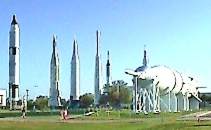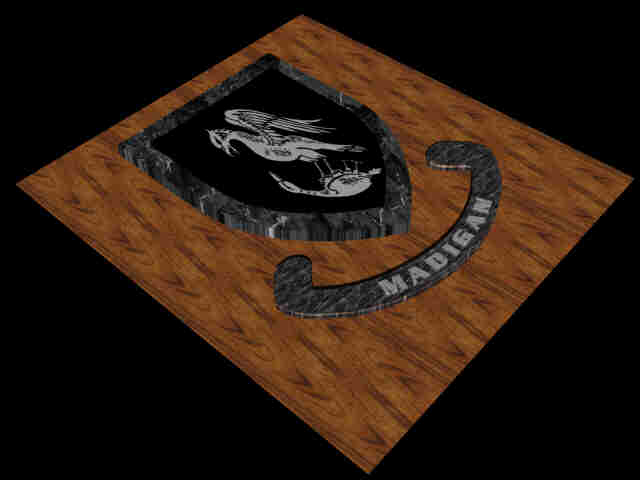The Kennedy Space Center
Cape Canaveral, FL
November 28th, 1999
We took a trip out to Cape Canaveral but
were turned away by security. The launch area is actually on an
Air Force Base which is still under a def-con alert which has
lasted since the last embassy bombing over a year ago. Only
military personnel are allowed on the base unescorted. We were
directed to the Kennedy Space Center which offers tours of most
of the space facilities as well has housing quite an exhibit area
itself. The front of the visitors center is distinctively
reminiscent of a theme park, complete with turnstiles and ticket
counters, which we had to pass to enter the display area. The
park, if one could call it that, takes up several acres with about half of
it open to the public. The remainder
a trip out to Cape Canaveral but
were turned away by security. The launch area is actually on an
Air Force Base which is still under a def-con alert which has
lasted since the last embassy bombing over a year ago. Only
military personnel are allowed on the base unescorted. We were
directed to the Kennedy Space Center which offers tours of most
of the space facilities as well has housing quite an exhibit area
itself. The front of the visitors center is distinctively
reminiscent of a theme park, complete with turnstiles and ticket
counters, which we had to pass to enter the display area. The
park, if one could call it that, takes up several acres with about half of
it open to the public. The remainder requires an access badge.
The badges create multi-level access according to price, with
only the highest level accessing all the attractions. We elected
to avoid the badges and wandered the public
sections. There is a shuttle mockup with a ramp that allowed us
to climb inside and see what life was
requires an access badge.
The badges create multi-level access according to price, with
only the highest level accessing all the attractions. We elected
to avoid the badges and wandered the public
sections. There is a shuttle mockup with a ramp that allowed us
to climb inside and see what life was  like during those days in
space. From the cockpit to the payload bay, the ship is quite
small to be spending any time living it. The living area is split
into two levels, while the cargo bay is all in one with the giant
robot arm swinging from the wall. The shuttle orbiter on display
was the "Explorer" which was lifted into space on the
back of an SRB and has a length of 122 ft. and a height of 56.7
ft. Its wingspan is 78.1 ft. and has a dry weight of 150,000
lbs. The three main engines can create a thrust
like during those days in
space. From the cockpit to the payload bay, the ship is quite
small to be spending any time living it. The living area is split
into two levels, while the cargo bay is all in one with the giant
robot arm swinging from the wall. The shuttle orbiter on display
was the "Explorer" which was lifted into space on the
back of an SRB and has a length of 122 ft. and a height of 56.7
ft. Its wingspan is 78.1 ft. and has a dry weight of 150,000
lbs. The three main engines can create a thrust  of394,260 lbs each, with a burn time per launch of
8.5 minutes. The cargo bay is 60 ft long and 15 ft wide capable
of carrying a 65,000 lb. payload. The SRB or solid Rocket Booster
was laying on its side next to the orbiter. It is 149 feet long
and 12.2 feet in diameter. Each weighs 1,300,000 lbs. The solid
propellant consists
of394,260 lbs each, with a burn time per launch of
8.5 minutes. The cargo bay is 60 ft long and 15 ft wide capable
of carrying a 65,000 lb. payload. The SRB or solid Rocket Booster
was laying on its side next to the orbiter. It is 149 feet long
and 12.2 feet in diameter. Each weighs 1,300,000 lbs. The solid
propellant consists  of aluminum powder, iron oxide and a
polymer binder. It is capable of a two minute burn after liftoff
creating 31 million tons of thrust. The rocket garden displayed
most of the rockets used by NASA from the Mercury series through
the Saturn V. Each had its own plaque describing the rocket's
function and size. One of the impressive points was the various
sizes of the rockets. The little Mercury looked like a toy some
rocket club would have shot up into the air, while the mighty
Saturn V was a giant among the other examples of rockets used
since the beginning of the space program.
of aluminum powder, iron oxide and a
polymer binder. It is capable of a two minute burn after liftoff
creating 31 million tons of thrust. The rocket garden displayed
most of the rockets used by NASA from the Mercury series through
the Saturn V. Each had its own plaque describing the rocket's
function and size. One of the impressive points was the various
sizes of the rockets. The little Mercury looked like a toy some
rocket club would have shot up into the air, while the mighty
Saturn V was a giant among the other examples of rockets used
since the beginning of the space program.
